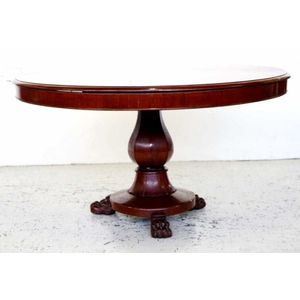Victorian Cedar Round Dining Table with Baluster Pedestal
Victorian cedar dining table with round top supported by a faceted baluster pedestal, 135 cm diameter, 75 cm high
You must be a subscriber, and be logged in to view price and dealer details.
Subscribe Now to view actual auction price for this item
When you subscribe, you have the option of setting the currency in which to display prices to $Au, $US, $NZ or Stg.
This item has been sold, and the description, image and price are for reference purposes only.
- Victorian Period - The Victorian period of furniture and decorative arts design covers the reign of Queen Victoria from 1837 to 1901. There was not one dominant style of furniture in the Victorian period. Designers used and modified many historical styles such as Gothic, Tudor, Elizabethan, English Rococo, Neoclassical and others, although use of some styles, such as English Rococo and Gothic tended to dominate the furniture manufacture of the period.
The Victorian period was preceded by the Regency and William IV periods, and followed by the Edwardian period, named for Edward VII (1841 ? 1910) who was King of the United Kingdom and the British Dominions and Emperor of India for the brief period from 1901 until his death in 1910. - Baluster (furniture) - An architectural term for a column in a balustrade or staircase, often defined as a "vase shape". The shape is extensively used in furniture and decorative arts.
In furniture, it is used to describe a chair or table leg turned in that form, or more usually as an inverted baluster, with the bulbous section to the top. Less commonly used to describe a chair back that has the outline of a baluster. A baluster may also be split and applied to the front of a cupboard for ornamentation.
For ceramics and silver items it is often used to describe the shape of the whole item, rather than a part.
In Georgian glassware, the shape is commonly seen in the stem of glasses.
This item has been included into following indexes:
- tables, large dining
- tables, material - Australian cedar 109
- tables, purpose or type - circular / round 115
